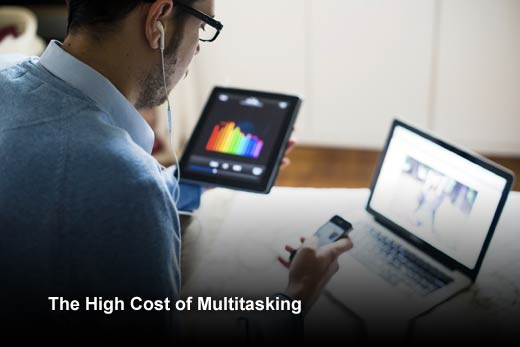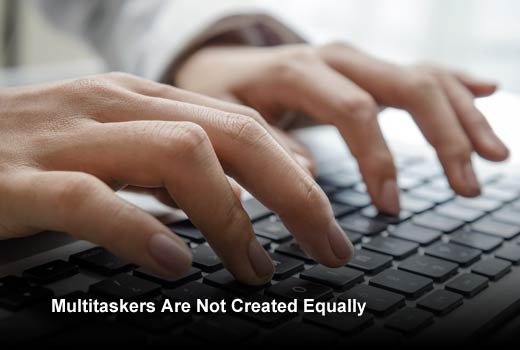The chaos of the modern workday creates constant pressure to multitask. We respond to emails during meetings, hold conference calls while driving, and reply to a constant inbound stream of messages while dealing with our workload. From email and chat notifications to the siren song of social media, there is always somewhere else for our minds to wander.
At first glance, this might seem like a good thing. Multitasking makes it possible to kill two birds with one stone, right? You discuss marketing strategy and catch up on your email at the same time. However, research now shows that multitasking is a serious drain on productivity. Rather than doing two things at once, it causes us to do two things badly, and perhaps create more work for ourselves down the road.
In today’s fast-moving, always-on office environment, employees and managers alike have to understand the high cost of multitasking. Shifting between tasks can cost as much as 40 percent of someone’s productive time. That is a massive sum, and one that can’t be ignored. In this slideshow, Andrew Filev, CEO of Wrike, delves deeper into the havoc multitasking can wreak on productivity and what you can do about it.

The High Cost of Multitasking
Click through for more on how multitasking wreaks havoc on productivity and what you can do to avoid the trap, as identified by Andrew Filev, CEO of Wrike.

Our Multitasking Addiction
According to Wrike’s Work Management Report 2015, the number-one productivity killer is “working on too many things at the same time.” Professionals today are addicted to multitasking, and it is hurting us.
To start, it is easier to multitask than ever before. We can constantly keep our email open on our desktop, browse multiple tabs, and work on our phones. The proliferation of devices creates a constant pressure to multitask, but just because we can, doesn’t mean we should. In addition, employers are still stuck on the idea that multitasking is a virtue, which is why so many job descriptions still ask for “good multitasking skills.” Collectively, all these forces compel us to work on too many things at the same time.

Mobile devices and social media have made us impatient and easily bored
Then there are the other pressures — for instant gratification and constant stimulation. The rise of mobile devices has also given rise to services like Uber, which enable us to get things done with just a few taps. The result of this rapid communicating — whether it’s texting a friend or calling a cab — has conditioned people to be inpatient and deal with things in-the-moment.
In addition, mobile devices and social media have created an environment where new things are constantly happening, even though they are often not important. A second of downtime (waiting in line, listening to a slow talker) has become time to fill.
This chronic impatience and boredom makes it more difficult for us to unplug and focus on one thing. As a result, no task gets our full and undivided attention, which means it also doesn’t garner the best of our abilities.

Multitaskers Are Not Created Equally
The experience of multitasking is not the same for all people, and understanding your relationship with multitasking can be helpful in your quest to overcome it.
According to the American Psychological Association, there are four common types of multitaskers:
- You’re approach-oriented or reward-focused. Your brain says “If I do more work at once, I can complete more work at once.” It makes sense, but doesn’t work.
- You’re a high-sensation seeker. These are people who use multitasking to fight boredom (or because of boredom). By shifting focus periodically, you keep your mind engaged with a new task.
- You’re convinced you’re part of the 2 percent of people who can multitask effectively. It’s normal for us to think we’re better at multitasking than we are. Be cognizant of your actual productivity, and see if you’re really as good as you think.
- You have trouble focusing. You may not be multitasking intentionally. Use technology as a tool for focus, rather than distraction. Mute your notifications, minimize your tabs, and avoid your inbox while focusing on work.
Most people are not proficient multitaskers (otherwise known as supertaskers). You are either one of the 2 percent or you’re not — there’s no gray area in between.

Productivity Drain
Switching between tasks drains 40 percent of our productive time.
A lot of productivity drain happens during the actual switch between tasks. As previously mentioned, switching sucks up 40 percent of our productive time, whether it’s changing apps, trying to catch up to where you left off, or getting distracted during the change.
To keep switching at bay, set a goal for each day. When a new task pops up, ask yourself, “Is this important for meeting today’s goal?” If not, it’s probably not something you urgently need to shift your focus toward.
Another good strategy to mitigate the effects of multitasking is to plan your day around similar tasks. For example, if you’re an HR pro, you may work on product-related tasks in the morning, legal-related tasks in the early afternoon, and recruiting a little later. That way, if you multitask slightly within those categories, your brain isn’t completely shifting topics.

Staying On-Task
How to stay focused and on-task
Avoiding the impulse to multitask can be difficult. Many of us today are engaged in collaborative work and we don’t want to let down our teams. For workers with many demands on their time and attention, setting goals and planning may not be enough to minimize distractions. Sometimes, more drastic measures are required.
If you can’t mute everything, funnel your inbound alerts into a single stream where you can prioritize some and reject others. You can also use apps to help you bundle and channel the noise. A little bit of time spent adjusting notification settings on the worst offenders (e.g., instant messaging) is a worthwhile endeavor. Set aside a few minutes at the top of an hour or every 90 minutes when you check in to see if anything needs immediate attention. For those moments when you need to get into the flow, enforce solitude by silencing notifications entirely.














